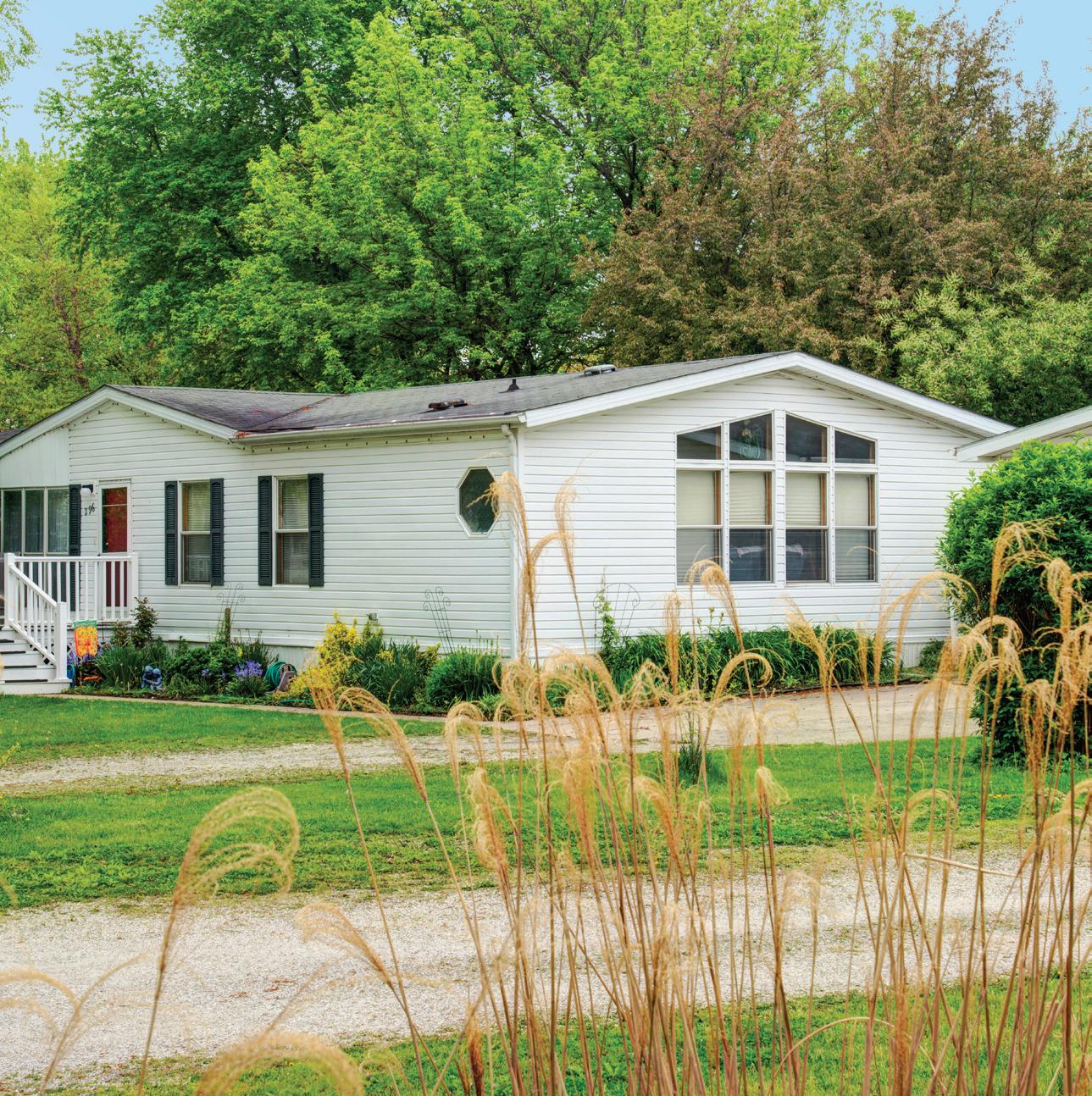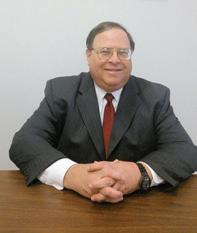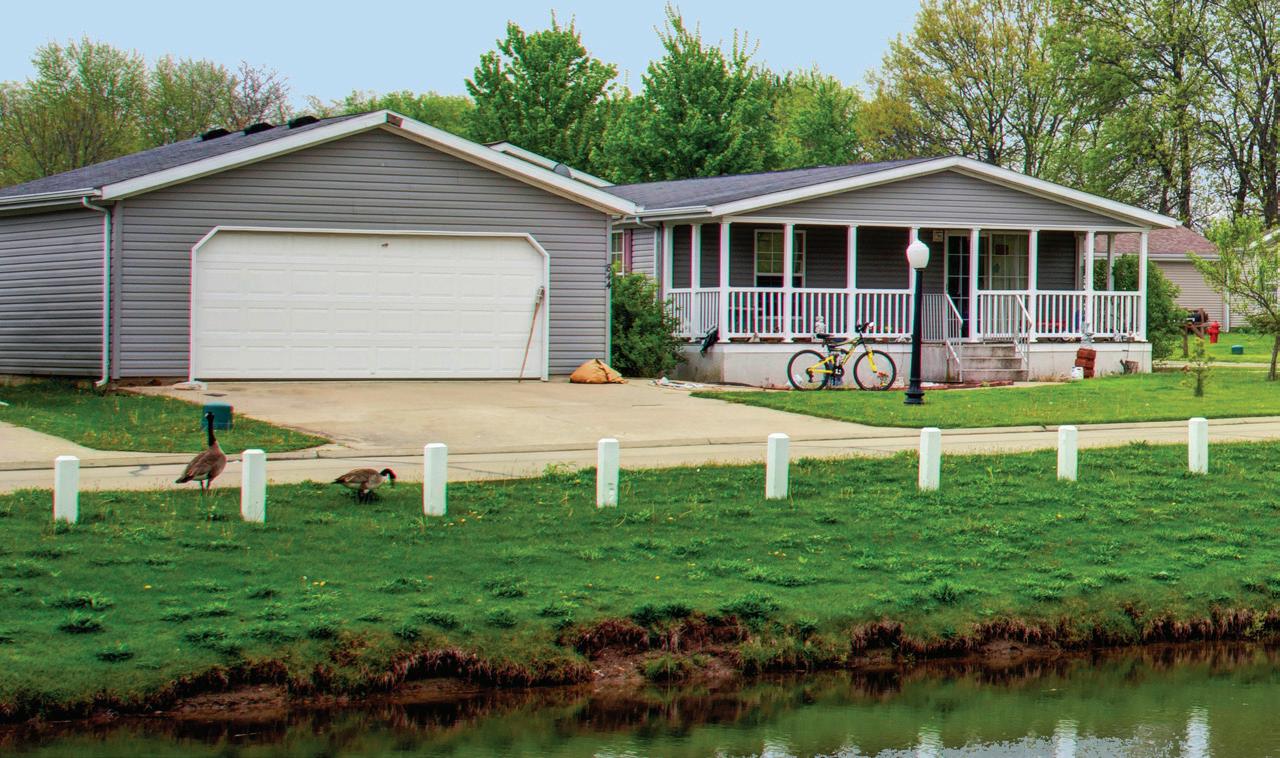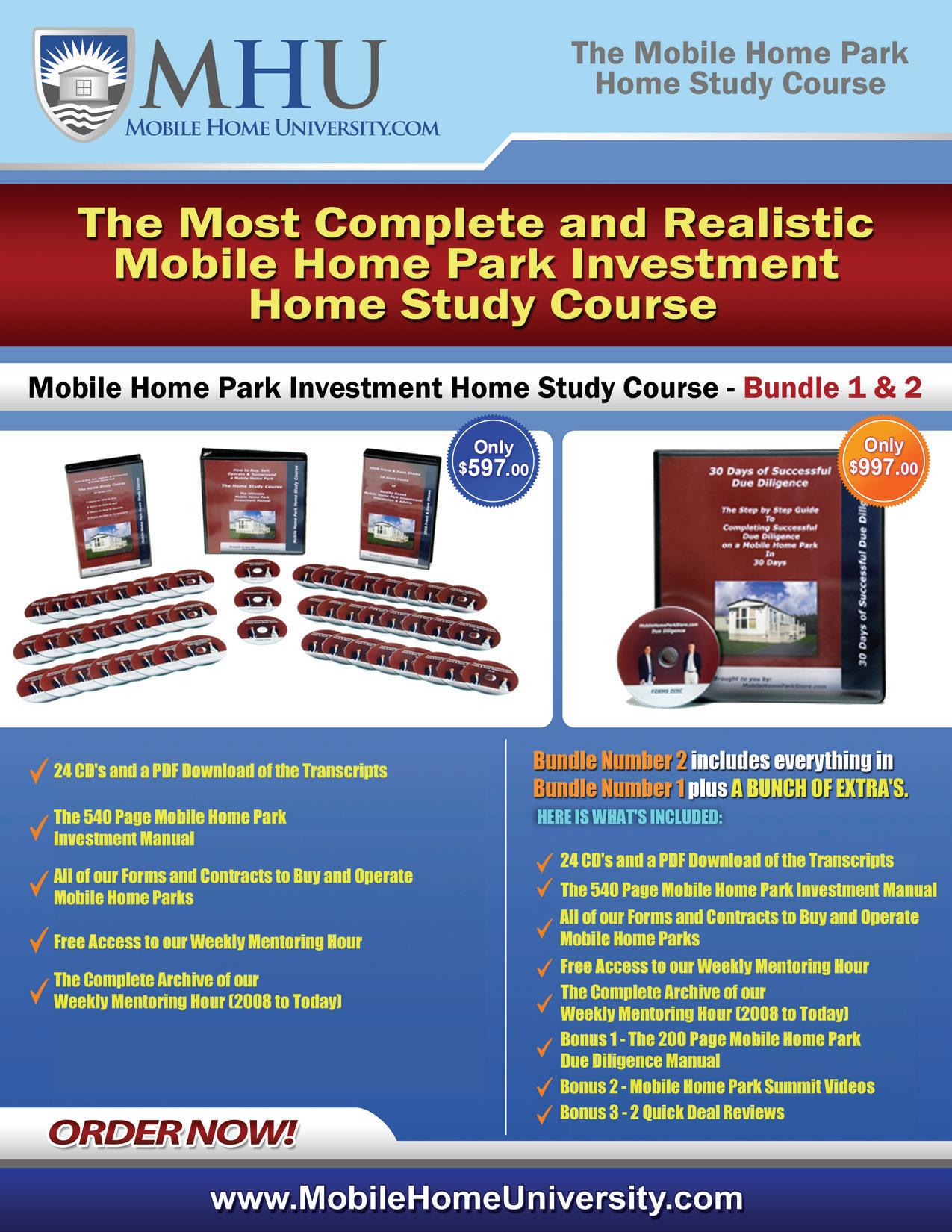MHR
MANUFACTURED HOUSING REVIEW

News and educational articles to help you run your business in the manufactured home industry.
IN THIS ISSUE:
For Manufactured Housing, the Obama Administration Never Left Town
Manufactured Home Discrimination Is Everywhere Marketing and Sales Pitches That Don’t Sell Hurricane Economics ... and much more!
SEPTEMBER 2017
3 Publisher’s Letter
By Kurt D. Kelley, J.D.
4 For Manufactured Housing, the Obama Administration Never Left Town
By Mark Weiss
7 Manufactured Home Discrimination Is Everywhere
By Crystal Adkins
12 Marketing and Sales Pitches That Don’t Sell
By John Graham
14 Hurricane Economics
By Brian Wesbury
16 With Thin Housing Market, Amarilloans Flock to Manufactured Homes
By Ben Egel
19 50 Inches
By Kurt D. Kelley, J.D.
Clayton Unveils ‘Have It Made’ Campaign to Promote: Homeownership 21 and Challenge Outdated Stigma about Manufactured and Modular Homes
By Patty Gregory
How To Create A Sense Of Community: Ideas From Tony Hsieh’s 22 Airstream Village
By Frank Rolfe
By Rick Robinson
National HUD Code Home Advocacy Group States: the Current HUD 27 Manufactured Housing Program Administrator is Both Unqualified and
By Mark Weiss
Table of Contents - AUGUST 2017 ISSUE
Paws & Effect: What You Need to Know About Emotional Support 24 Animals and Fair Housing Law
to
Failing
Follow Federal Law Mandates
Publisher’s Letter
As the devastating rain and wind from Hurricane Harvey cease and the destruction left behind is revealed, it’s clear the Manufactured Housing Industry will be the salvation of many. Manufactured homes are a good solution to the immediate housing needs of thousands who have been displaced by this disaster. While we don’t build the biggest, most expensive homes, we do build what’s needed now –quality affordable housing, and we do it better than anyone. Time is of the essence, and speed one of our inherent traits.

Supported by many smart and caring manufactured home professionals, the Texas Manufactured Housing Association’s Executive Director, D.J. Pendleton has taken the lead to catalogue resources and communicate them to those in need. Community owners need clean up contractors and homes. Retailers need home buyers and places to site their homes. Transporters and installers need their phones to ring and their dance cards full. Manufactures need home buyers.
By Kurt D. Kelley, J.D. Publisher
Manufactured home financiers need those willing to take out loans. Manufactured home insurers will provide much of the capital needed to feed this entire process but most importantly victims of Harvey need a place to live.
The damage done was catastrophic with thousands of homes destroyed. We are the right industry for the right time. The water has receded and the sun is shining...let us begin the work.
Kurt D. Kelley, J.D. Publisher

SEPTEMBER 2017 ISSUE • 281.460.8384 • ManufacturedHousingReview.com - 3 -
For Manufactured Housing, the Obama Administration Never Left Town Issues and Perspectives
By Mark Weiss
Recognizing that excessive government regulation plays a major role in stifling economic growth while inflicting disproportionate harm on the multitude of small businesses that are the engine of job creation within the American economy, President Trump came to office in January 2017 on a platform of “deconstructing the administrative [i.e., regulatory] state.”
Consistent with this pledge, the Trump Administration, in rapid succession, took specific actions designed to slow, halt and, eventually, reverse the growth of the federal regulatory monster. Among other things, the new Administration: (1) imposed a “regulatory freeze” order on January 20, 2017, requiring that any new “regulatory action” by a federal Executive Branch agency be approved by an agency head or designee appointed by President Trump; (2) issued Executive Order (EO) 13771 on January 30, 2017, requiring, among other things, that any federal agency proposing a new regulation for notice and comment “identify at least two existing regulations to be repealed;” and, most significantly, (3) issued EO 13777 on February 24, 2017, stating “It is the policy of the United States to alleviate unnecessary regulatory burdens placed on the American people,” while establishing a process for agency review, modification, and/ or repeal of existing regulations that “eliminate jobs or inhibit job creation, are outdated, unnecessary, or ineffective, or impose costs that exceed benefits.”
So, what impact – if any – have these policies had on federal regulatory activity thus far? A study published on August 8, 2017 by the American Action Forum (AAF), a Washington, D.C. government watchdog organization, tells the story. Over the first six months of the Trump Administration, AAF found that “new regulatory burdens are a fraction of those established under President Obama’s first six months,” while “overall regulatory volume has slowed to historically low levels.” (Emphasis added). More specifically, the AAF data shows that “compared to the [first six months of the] Obama Administration, the Trump Administration has imposed: 1/20th of the lifetime costs, 1/11th of the annual costs, and 1/8th of the paperwork.” This translates into “nearly 6 million fewer paperwork burden hours [and a] workload savings of roughly 3,000 full-time employees.” Thus, according to AAF, “both the volume and impact of new regulatory burdens have slowed dramatically.” (Emphasis added). Combined with 3% growth in Gross Domestic Product (GDP) over the
second quarter of 2017 (the first full economic quarter of the Trump Administration), this represents outstanding news for the nation’s economy and many, if not most, regulated American businesses.
But that is where the good news ends, at least for the manufactured housing industry and its consumers, because the regulatory reform agenda of the Trump Administration appears, so far, to have eluded the federal manufactured housing program which, under its Obama Administration holdover-Administrator, continues to operate and function -- and churn out costly new regulatory mandates -- like the Obama Administration never left town. And the industry, sadly, has no one to blame but itself, as the traditional “goalong-to-get-along” mentality of some seems not to have changed one bit to adjust to the new reality of the Trump Administration’s regulatory reform agenda.
Two metrics objectively establish this regulatory reform disconnect. First, compare the regulatory activity of the HUD manufactured housing program with the governmentwide assessment of regulatory activity conducted by AAF. While government-wide regulatory activity under the Trump Administration has reached historically-low levels, regulatory activity within the HUD manufactured housing program, over the past six months, has not slowed at all and, if anything, appears to have intensified, with the program in the process of pursuing multiple new regulatory mandates that would significantly and unnecessarily increase consumer costs and industry regulatory burdens.
These include, but are not limited to: (1) an impending proposed rule to establish multiple new manufactured housing standards as announced in the latest federal Semi-Annual Regulatory Agenda (SRA); (2) the pending Interpretive Bulletin (IB) for “frost-free” foundations (IB I-1-17), which, in fact, constitutes a substantive change to the existing HUD standard with no cost or needs analysis in violation of the Manufactured Housing Improvement Act of 2000; (3) the pending effort to dictate installation standards in all 50 states that will add needless costs while undermining the federal-state partnership at the heart of federal manufactured housing law; (4) the continuing expansion of Subpart I requirements, including “at least monthly” service record reviews; (5) intensified, expanded and costly (yet unnecessary) in-plant regulation, which was
SEPTEMBER 2017 ISSUE • 281.460.8384 • ManufacturedHousingReview.com - 4 -
established unlawfully to begin with; and (6) multiple other actions under the guise of interpretations and “guidance” (involving, among other things, designs to accommodate attached garages and carports), without adherence to statutory safeguards, among other things.
Second, compare the pace of regulatory activity within the federal manufactured housing program to the pace of regulatory activity within HUD as a Department – again, over the first half of 2017. The HUD SRA published in lateAugust 2017 shows only one proposed rule in process for the entire agency – that being a proposed rule for new manufactured housing standards, targeted for publication in September 2017, to “add new standards that would establish requirements for carbon monoxide detection, stairways, fire safety considerations for attached garages, and draftstops when there is a usable space above and below the concealed space of a floor/ceiling assembly.” (Emphasis added). In addition, the impending proposed rule, according to HUD, “would establish requirements for venting systems to ensure that proper separation is maintained between the air intake and exhaust systems.”
Thus, while rulemaking activity and the imposition of new regulatory burdens is down substantially at other federal agencies – and even at HUD -- as shown by the August SRA, the manufactured housing program, under its holdover administrator, continues to cruise along with new, expanded and intensified regulation like it’s the height of the Obama administration – because within the HUD program, it is.
Simply put, the HUD manufactured housing program continues to regulate like the Obama administration is still in power, because the program continues to be run by an Obama administration holdover, with a regulatory outlook consistent with that of the former president, not President Trump. Thus, it should be no surprise that in open defiance of the new administration, the program has moved forward with multiple regulatory actions that, at a minimum, should have been – and should have remained – “frozen” under the president’s order of January 20, 2017 and should never have even seen the light of day under an Administration dedicated to “alleviat[ing] unnecessary regulatory burdens … on the American people.”
Even worse, where regulatory changes could actually help the industry to be more competitive with other types of housing
– particularly lower-priced site-built homes – and help provide American consumers with more affordable housing options and choices, change has not been forthcoming. The most notable example of this phenomenon is the recommendation of the Manufactured Housing Consensus Committee (MHCC) to amend the federal manufactured housing standards so as to permit multi-family manufactured homes (and simultaneously overturn a ruling of the current administrator against home designs that could facilitate multi-family use) which has languished since 2015. Such a change would not only help consumers, but would allow the industry to expand its market and production numbers that continue to hover well-below its vast and unlimited potential. This is just one illustration of how the industry and its consumers have gotten the worst of all worlds under the current administrator.
So, who benefits from all this and why does it continue unabated, at least for now? The beneficiaries are easy to identify. They include industry competitors, who understand all too well the price and market advantages that manufactured housing, unshackled from excessive and unnecessary federal regulation, could bring to the table. They include entrenched program contractors (one under a de facto 40-year sole source contract – unheard-of, even by Washington, D.C. standards), which never miss on opportunity – in conjunction with HUD regulators – to create and generate new make-work functions and new billings, leading to ever-increasing revenue, and they include the industry’s largest businesses (now edging into the sitebuilt market), which skillfully manage, to their advantage, a regulatory playing field that disproportionately harms and disadvantages smaller competitors which are forced to distribute regulatory compliance costs over a smaller production base.
As for why the unacceptable status quo continues, part of the problem is the slow pace of nominations and confirmations of HUD officials below the Secretary level –which is beyond the industry’s control. Just as significant, though, if not more so, has been the failure of part of the industry itself – the same part that paved the way for the installation of the current administrator to begin with – to join MHARR and others in the industry in publicly and forcefully demand the administrator’s re-assignment and replacement with a qualified appointee. Muddying the proverbial waters with misinformation, misguided policies and “feel-good”
SEPTEMBER 2017 ISSUE • 281.460.8384 • ManufacturedHousingReview.com - 5 -
For Manufactured Housing, the Obama Administration Never Left Town cont.
For Manufactured Housing, the Obama Administration Never Left Town cont.
initiatives (at a time when Trump Administration regulatory reform policies are already in place), will simply not get the job done, insofar as the root of the continuing problems within the program – i.e., the current program administrator -- remains.
With industry production continuing at levels below 100,000 homes per year and with consumers ultimately forced to pay for unnecessary regulatory mandates and contractor makework, the leadership of the program must change to one that
will comply-with and embrace the regulatory reform agenda of President Trump in order for the industry to advance and grow to its full potential. Indeed, there will be no change for the better for the industry and its consumers, unless and until a new and fully-accountable appointed administrator takes control of the program and institutes thorough reforms including, most especially, a top-to-bottom reform of the program contracting process which has been a key element of the baseless over-regulation of the industry for decades.
MHARR is a Washington, D.C.-based national trade association representing the views and interests of independent producers of federally-regulated manufactured housing.
“MHARR-Issues and Perspectives” is available for re-publication in full (i&., without alteration or substantive modification) without further permission and with proper attribution to MHARR.
Mark Weiss is the President and CEO of the Manufactured Housing Association for Regulatory Reform (MHARR) in Washington, D.C. He has served in that position since January 2015 and, prior to that, served as MHARR’s Senior Vice President and General Counsel.
MHARR is a national trade organization representing the view and interests of producers of HUD Code manufactured housing. Its members are mostly smaller and mid-sized manufacturers from around the country. Founded in 1985, MHARR is dedicated to fighting excessive and unnecessary regulation, to protecting, defending and advancing manufactured housing in accordance with federal law, and to preserving the affordability and availability of manufactured housing.
An honors graduate of Rutgers University with a degree in Political Science, Mr. Weiss received his Juris Doctor degree from the

George Washington University School of Law in Washington, D.C. in 1983 and began working on manufactured housing regulatory issues almost immediately as an attorney for the firm of Casey, Scott & Canfield, P.C. -- then General Counsel for the Manufactured Housing Institute (MHI), and later General Counsel for MHARR. Mr. Weiss later became General Counsel for MHARR in his own right and, in 2006, was named as MHARR’s Senior Vice President.
During his career with MHARR, Mr. Weiss has been involved in formulating and supporting MHARR policies with respect to nearly every aspect of the federal regulation of the manufactured housing industry. He played a direct role in the development and passage of the Manufactured Housing Improvement Act of 2000 and has worked to advance the views and interests of the industry’s smaller businesses before Congress, HUD, the federal Manufactured Housing Consensus Committee (MHCC) and other government agencies, boards and committees. In recent years, moreover, given the increasing difficulties of the industry’s postproduction sector (including retailers, communities and finance companies), Mr. Weiss and MHARR have become progressively more involved with advancing the regulatory perspective and interests of this important segment of the industry as well. Most recently, Mr. Weiss served as a member of the U.S. Department of Energy (DOE) Working Group on manufactured housing energy conservation standards, voting against those proposed standards – and leading the industry effort to roll-back those proposals -- that would significantly and needlessly increase the cost of manufactured homes for American homebuyers.

SEPTEMBER 2017 ISSUE • 281.460.8384 • ManufacturedHousingReview.com - 6 -
Mark Weiss
Manufactured Home Discrimination Is Everywhere
Manufactured home discrimination is a very real issue in America. Manufactured homes and the people living in them are one of the few remaining groups that face outright discrimination and bias. This isn’t about namecalling or humorous jabs, either, there are outright bans on manufactured homes in towns across the nation. Discrimination doesn’t get much more obvious than that!
Manufactured Home Discrimination is Everywhere!
In addition to outright housing bans, manufactured home owners face blatant discrimination in practically every industry involving housing: finance, insurance, and real estate.
Banks usually refuse to finance most manufactured homes or if they do finance them they have numerous restrictions. Insurance companies use unfounded data to charge more to insure a manufactured home over a site-built home. Realtors and appraisal companies often refuse to deal with manufactured homes at all.
Manufactured Homes are Banned Across the Nation!
Many people have protested, both publicly and privately, to keep manufactured homes away from their site-built homes for fear of lower property values and higher crime rates. In response to these protests, towns have been placing land use restrictions on manufactured homes for decades.

Man, They Sure Do Hate Single Wides!
One of the most popular land use restrictions involves single
By Crystal Adkins MobileHomeLiving.org
wides, they are not allowed within city limits in most areas of the nation.
My hometown in West Virginia, in one of the poorest counties in the entire country, prohibits single wides from being installed within city limits. This is a town of coal camp homes that are over 60 years old and built with no insulation (maybe a single layer of newspaper). The walls are often framed with 2’x 2’ studs but a brand new single wide isn’t allowed. Luckily, our property is grandfathered in so if we remove our single wide from the property we have one year to install a new single wide, otherwise only a double wide will be allowed.
Double wides are a bit more acceptable but the list of regulations they must meet are usually long and expensive. Common restrictions are roof pitch, siding material, foundation design, skirting, and even landscaping.
They Don’t Like Manufactured Home Communities Much, Either
It isn’t just the homes that are discriminated against, entire manufactured home communities have been kept from development due to mundane ordinances and land use laws. These parks don’t even have to be close to the gated communities. A manufactured home community going in on the same road can cause protests.
According to Frank Wolfe, co-owner of the 5th largest manufactured community in the United States, new manufactured home park construction is effectively banned in almost every major city in the U.S., “There are less than ten mobile home parks built per year in the entire nation combined.” (manufacturedhomes.com)
If one manufactured home can plummet property values and bring drug dealers and violence into a community just imagine what several manufactured homes would do?
NIMBY – Not in My Neighborhood!
These regulations and bans against manufactured homes are due to a phenomenon called ‘not in my neighborhood.’ NIMBY is a fear and prejudice based on emotions more than actual facts or data. Some people can’t let their bias of mobile homes go even though their opinions are based on decades old experiences and unfounded data. You could give them endless statistics and data backed up by undeniable resources but it
SEPTEMBER 2017 ISSUE • 281.460.8384 • ManufacturedHousingReview.com - 7 -
Manufactured Home Discrimination Is Everywhere cont.
will never change their opinions. They don’t understand that the modern manufactured home is a completely different thing from the older, and much more mobile, homes of the past.
But Unwritten Bans on Manufactured Homes are Just as Common!
In some cases, a town may not have a written ban on manufactured homes but that doesn’t mean they actually allow them. They simply put the burden on the building inspections and permitting office to ensure all new homes meet the codes and the standards of the neighborhood, and the neighbors, and the nearby businesses. It’s not hard to create a situation where it becomes too expensive to install a manufactured home. We actually suspect that exact scenario happened to one of our readers. You can’t fight unwritten bans. Heck, you can barely fight written bans without a lot of money and a ton of connections.
Discrimination Against Buyers that Don’t Own Land!

If you want to buy a new manufactured home and install it in a beautiful manufactured home community you will likely be restricted to a personal loan or chattel loan at higher interest rates.

Manufactured Home Discrimination in Banking and Finance!
It’s no secret that many lending institutions refuse loans for manufactured homes. Finance discrimination of manufactured housing begins with the US government. Fannie and Freddie maintain a distinct set of criteria for mortgages secured by manufactured housing that include more demanding appraisal requirements and, for some lenders, an extra pricing charge. Fannie Mae does not permit state housing finance agencies (HFAs) to include MH mortgages in their preferred pricing programs for securitized loan sales. Most lenders follow the lead established by the GSEs (whether or not they actually sell loans to the GSEs) and treat manufactured housing mortgages as different than mortgages for site-built homes. Many lenders simply avoid MH entirely.
It’s a system setup to benefit a select few and was created by design. It’s no accident that you will probably have to finance your new manufactured home through the very dealer that sold it to you and at higher interest rates than comparable home loans. It’s a ‘buy here, pay here’ deal for manufactured housing instead of used cars! Ironically enough, manufactured home salespeople are paid on commission just like a used car dealer.
One study indicates that the rates for chattel loans are typically at least two to five percentage points higher than those on mortgages for similar homes and that the chattel loans typically hold twenty-year, rather than thirty-year, terms. A 2006 study found one lender’s chattel loan rates ranged between seven and 10.5%, and a second lender’s between 7.5% and 15%.
They Discriminate against Land Owners, too!
Don’t worry, manufactured home buyers that own their own land will likely face discrimination as well. If you do own your land that the home will be installed on you will probably be asked to use it as collateral against the home loan. If I own my land, I should be able to put any kind of home I want on it. I can understand restrictions if the property is within a gated community or part of a housing authority but not private property.
SEPTEMBER 2017 ISSUE • 281.460.8384 • ManufacturedHousingReview.com - 8 -
Manufactured Home Discrimination Is Everywhere cont.
Are Manufactured Home Loans Really More Likely to be Foreclosed?
Nope. These higher interest rates are not warranted. Recent analysis shows that manufactured home loans perform just as well as site-built home loans. In a couple of areas, they actually do better than site-built home loans! A groundbreaking I’M HOME report released this week by CFED in partnership with the Fair Mortgage Collaborative, titled Toward a Sustainable and Responsible Expansion of Affordable Mortgages for Manufactured Homes, analyzes $1.7 billion in loan performance data and finds that, contrary to common belief, mortgages on manufactured homes perform as well as comparable site-built home mortgages.
The study goes on to identify manufactured home mortgage products that actually outperform other loans.
Manufactured Home Discrimination in Appraisals!
The discrimination within the manufactured home financing industry begins with home appraisals. Many within the industry believe that real property appraisers commonly appraised manufactured homes for far less than they are actually valued. This, in turn, is reflected by the poor loan rates. It’s a vicious cycle…in some cases, appraisers may undervalue a property simply because it is manufactured housing, without adequate regard for the factors that should be taken into account in an appraisal: quality, appearance, interior finishes, other similar characteristics and truly comparable sales. The issue is important because an appraisal that does not value a manufactured home appropriately may prevent borrowers, particularly those with low or moderate incomes, from obtaining the financing that they need to purchase a home, and may artificially depress the asset value of a home, even if the owner has made major investments in it.
ManufacturedHomes.com argues that it is a common practice for home appraisers to automatically lower the value of a home as soon as they determine it to be manufactured. In turn, lenders will use these lower appraisals as justification to discriminate against the manufactured home borrowers.
Realtors Spread Misinformation!
Zillow, a popular online real estate listing site, has an advice thread that allows potential homebuyers to ask licensed real estate agents questions. It was in one of these threads that I learned about the rampant misinformation and outright lies that licensed real estate agents tell people about manufactured homes. The question was simple enough, Are Manufactured
Homes A Poor Choice in Housing? Unfortunately, over 40 agents freely provided answers that were based on opinion and emotion far more than actual data.
Manufactured Home Discrimination in the Insurance Industry!

One of the best examples of blatant and obvious discrimination against manufactured housing is within the insurance industry. It’s difficult to find an insurance company to insure a manufactured home and if they do it’s not gonna be cheap. You’ll have an even tougher time finding a company that will cover an older manufactured home or mobile home. You’d think, based upon this difficulty, that manufactured homes were more likely to catch fire or burn completely down, huh? That’s not the case at all! In fact, manufactured homes built after 1976 (when the HUD Code became law) have 38-44% FEWER fires than site-built homes!
Here are a few more facts from the 2013 National Fire Protection Association (NFPA) report comparing fires of manufactured homes against site-built homes: The fire death rate in HUD Code homes, those built after 1976, was equivalent to other site-built housing, and that manufactured homes have 38-44 percent fewer fires than site-built homes. Manufactured homes have essentially the same fire death rate as other single-family residential homes.
Manufactured homes have a lower rate of civilian fire injuries per 100,000 occupied housing units than other one or twofamily homes and post-HUD standard manufactured homes are more likely than other homes to have fires confined to the room of origin. Insurance companies certainly don’t want the
SEPTEMBER 2017 ISSUE • 281.460.8384 • ManufacturedHousingReview.com - 9 -
Manufactured Home Discrimination Is Everywhere cont.

truth about manufactured homes to come out. Consumers don’t complain much if they really think manufactured homes catch fire more.
Journalists!
I wrote a whole article a few years ago about the obvious discrimination against manufactured homes within the modern journalism and mass media industry. Ever notice that you read a lot more about fires, thefts, murders, and other nefarious activities when it involves a mobile home than you do with sitebuilt homes?
How Do We Fix Manufactured Home Discrimination?
We’ve established that manufactured homeowners are systematically treated differently by governments and industries. This isn’t just silly name-calling here, this is life-altering issues that impact our lives tremendously. So, how do we fix it? Speaking out against manufactured home discrimination is an important step. Most of us are so accustomed to the discrimination we don’t even realize it’s happening.
Education!
I believe knowledge is power. When people understand what they are up against when it comes to manufactured homes it makes for a more powerful consumer. We aren’t just fighting silly little opinions and rumors here. We are fighting against
huge industries and governments that are making huge profits because of this manufactured home discrimination. We have to be vocal about these issues and make people understand that affordable housing has an important role in our country and that their fears are based on lies and emotions and not facts.
Getting Help from Organizations!
One person may not be able to make a big difference against manufactured home discrimination but many people working together can. Thankfully, there are several national organizations that are fighting manufactured home discrimination. Organizations such as Corporation for Enterprise Development (CFED), Manufactured Home Owners Association of America (MHOAA), and the National Consumer Law Center (NCLC),
Crystal Adkins is creator and publisher of the online magazine, Mobile & Manufactured Home Living and the manufactured home expert for About.com. I take the advocacy of manufactured homes seriously because our homes, and the people that choose to live in them, deserve to be respected. Her articles have been featured nationally on several websites and she is the author of 3 e-books about mobile homes. She started MHL after buying a 1978 model single wide and after looking for ideas online found nothing. She saw a void for mobile home owner resources and decided to fill it.

SEPTEMBER 2017 ISSUE • 281.460.8384 • ManufacturedHousingReview.com - 10 -

Marketing and Sales Pitches That Don’t Sell
Sales pitches are short-cuts that save time and don’t require thinking. They’re the stock-in-trade of salespeople, rolling off the tongue easily and unconsciously. They once worked well with customers, but not so much today. Here are some of them:
“How can I help you?” This one gets top billing on the list, and deservedly so. It’s leftover from the last century, when customers needed assistance and relied on salespeople and marketers, as well as the iconic Sears catalog, to point them in the right direction, followed by the ubiquitous shopping mall. While the former is long gone, the latter is fast going dark.
When you think about it, “How can I help you?” is insulting, a turn off and a crutch, as if customers lack the ability to identify what they want and then to find it. A more adult approach would be, “Let’s talk about what you have in mind.” The role of salespeople and marketers is no longer that of a guide, directing customers to what they want to sell them. Those who make sales are coaches, who take the time to figure what’s in the customer’s best interest.
“We are the competition.” While it may work for Ferrari, this one is nothing more than a self-serving attempt to raise the “look no further” flag. A company that believes it’s out in front of the pack can back up the claim by comparing their product or service so customers can make that judgment for themselves.
There are no secrets today so attempts at obfuscation or pulling the wool over the customer’s eyes is self-defeating.
“I have just what you’re looking for.” This might be described as the “Presumptive Opening” or, more accurately, as the “This is what I’m going to sell you, so save time by getting your wallet out now” strategy. Rather than attempting to engage customers, it’s more akin to browbeating than anything else. On top of that, it’s repulsive and demeaning to customers.
“We’ve been in business for 37 years.” There was a time when longevity made a compelling statement for customers, sending a message of stability and that somebody was doing something right. Not now. In fact, it may be just the opposite in the customer’s mind, as companies merge, fail, and, more likely, fall behind.
By John Graham
Old is out. Today, customers flock to start-ups, the new, and the innovative, particularly if the CEO is 23, not 63.
“You’re going to love this.” Whether it’s a house, an engagement ring, or a refrigerator, telling customers what to think can mean trouble. It’s demeaning, particularly when a stranger, such as a salesperson, does it. And it can come back to bite you. Even though customers make a purchase, they can come to resent being told how they should think about what they buy—and then comes a canceled order or a quick return. And no more sales.
“You’ll never do better than this price.” Sure, everyone in marketing and sales is justifiably concerned with price, more so every day. But that’s no excuse for arrogantly announcing to customers that they’re, in effect, stupid not to buy from you.
Such tactics may have worked in the past, but today’s customers don’t respond positively to such tactics. They want the evidence and they feel capable of their own research, even as they’re talking to a salesperson.
“Time is running out. Once they’re gone, they’re gone.” Yes, and you might want to throw in “Order now. Only 11 in stock.” Scarcity gets attention, as psychologists tell us. We balk at losing something we already have for the possibility of greater gain. This can help explain the appeal of mutual funds vs. buying individual stocks.
Yet, we also don’t want to lose something we don’t have, particularly if it’s in scarce supply. It’s not surprising that such pitches as “Prices going up in 2 days” and “Only 3 left in stock” are irresistible, and, like magic, compel many customers to hit the “Buy now” button. While there are takers, the more thoughtful and better-informed buyers say, “Thanks, but no thanks.”
“I can see you know what you like.” Customer want to be treated with respect, but today’s customers avoid manipulation by fake praise that’s designed to create a “bond” with the salesperson. Instead of dwelling on ways to get the sale, it’s far better to focus on listening thoughtfully to what a customer says and the questions they ask.
“I don’t know how long that’s going to be available.” An upscale retailer had a one-day furniture sale and the place
SEPTEMBER 2017 ISSUE • 281.460.8384 • ManufacturedHousingReview.com - 12 -
Marketing and Sales Pitches That Don’t Sell cont.

was jumping. Months later, there was a two-day sale event for customers. Much of the same merchandise was shown at the original “special price.”
Playing games with customers destroys buyer confidence and can have long-term negative consequences. No one wants to be played for a fool.
“Your friends will love it.” This one is used as the “persuader,” when selling everything from clothing to homes, cars, furniture and jewelry, and the like. It’s aimed at the unsure, the indecisive, the confused, and those who don’t trust their own judgment. It’s as if the customer’s friends got together to give their permission to say yes, a ridiculous idea.
“If you can get a better deal, take it.” This sounds as if a salesperson is daring the customer to find a better price.
Not so. In reality, the purpose is to get the customer to back down, to give up and capitulate, and buy now. Today’s savvy customers don’t take the bait. Instead they take the advice, track down a better deal—and take it.
So, what? Thoughtful salespeople and marketers are aware of the words they use with customers. Do they send the right message? Are they helpful in closing more sales? Or, are they repeated endlessly without thought or meaning?
John Graham of GrahamComm is a marketing and sales strategy consultant and business writer. He is the creator of “Magnet Marketing,” and publishes a free monthly eBulletin, “No Nonsense Marketing & Sales Ideas.” Contact him at jgraham@grahamcomm.com, 617-7749759 or johnrgraham.com.

SEPTEMBER 2017 ISSUE • 281.460.8384 • ManufacturedHousingReview.com - 13 -
The hits keep coming. Hurricane Harvey and Irma have left destruction in there wake.
It’s been five years since Hurricane Sandy, nine years since Ike and twelve years since Katrina. As with all major weather events, personal tragedy, pain, suffering, and loss are left in their wake. We have prayed, and continue to pray, for those affected. But at the same time, in our job as economists we look toward rebuilding and economic restoration. This is where investors often make two different mistakes about how these massive weather events will affect the economy and markets.
Some might think that, as did Nouriel Roubini after Katrina, the damage itself will cause a recession. Others take the opposite tack and think rebuilding efforts might actually help the economy. Neither are correct. By themselves, the storms will not push the economy off its Plow Horse path.
In the face of disasters we should all be thankful for the (mostly) free markets that help the U.S. respond. These markets allow accumulated wealth and know-how to focus on recovery. The losses will never be fully replaced, but the sheer size and flexibility of the U.S.’s capitalist system allows resources to be shifted and directed toward recovery. The price system makes this happen. While some think no profit should be made from a disaster, it is those profits which allow overall “economic” recovery to occur in relatively quick order.
Some estimate that damage from Harvey could be close to the $108 billion estimate for Katrina (2005), certainly above the $75 billion cost of Hurricane Sandy (2012).
Neither of these previous storms caused a recession, and at the same time, the data show no real acceleration in growth either. Real GDP grew 4.9% at an annual rate in the first quarter of 2006 after Katrina, but never accelerated above 3% in the first two quarters after Sandy. For six and nine month periods before and after these storms, growth rates were similar. In other words, it’s hard to separate the impact of Katrina or Sandy from normal statistical noise. The U.S. grew over 4% annualized in Q1 2005 and in Q3 2014, with no major weather impact.
But even if the bump in real GDP growth in the first quarter of 2006 was due to Katrina, that doesn’t mean it was good news.
It would be what Henry Hazlitt in his book “Economics in One Lesson” called the “fallacy of the broken window” – which we recommend all investors read.
Hazlitt told a story about a vandal who broke a shopkeeper’s window, which caused a glassmaker to get an additional order. But the shopkeeper was planning on eventually using that same money to buy a new suit, so the tailor lost an order. In other words, even though rebuilding appears to create new economic activity, fixing things that have been destroyed actually robs an economy over time of the benefits of growth. Repairing physical capital does not generate new wealth, it only replaces old wealth.
Before Harvey, the market consensus was that automakers would sell cars and light trucks at a 16.6 million annual rate in August. Instead, automakers reported late on Friday that they only sold at a 16.1 million rate. Harvey hit an area that represents about 5% of US auto demand and it did so for about 20% of August. This suggests Harvey cut roughly 1% off of August sales nationwide, or that autos would have sold at a 16.3 million annual pace in the absence of the storm.
Automakers should make those sales back up in the next few months. In addition, reports suggest the storms destroyed about 500,000 autos, which will also generate additional sales in the months ahead.
These sales might help make the GDP numbers look better late this year or early next year, but it just represents demand that would have eventually appeared elsewhere in other sectors.
The lesson is that these disasters, while a tragedy in so many ways, do not shift the fundamental path of the U.S. economy. Some think socialist economies can respond better, but this is not true; markets are the most efficient system for guiding resources to areas in need. Free people that get hit with a disaster will overcome and reach new highs, because that’s what people do when they’re free, disaster or not. Godspeed to all those affected directly, and to those helping in recovery.
SEPTEMBER 2017 ISSUE • 281.460.8384 • ManufacturedHousingReview.com - 14 -
Brian S. Wesbury, Chief Economist, Morgan Stanley, First Trust Portfolios. Follow at youtube.com/user/firsttrustadvisors and Robert Stein, Deputy Chief Economist, Morgan Stanley.
Hurricane Economics By Brian Wesbury

With Thin Housing Market, Amarilloans Flock to Manufactured Homes

Abel Deterts, 5, left, laughs with his grandmother Tammy Deterts, center, and mother Terina Deterts in their home in north Amarillo. The Dertert family has been living in a mobile — or manufactured — home for the last ten years because it has allowed freedom to live outside city limits, away from the crowds. They also own a sizable piece of land to boot. (Lauren Koski/Amarillo Globe-News)
Country Estates at Roberts Communities in Amarillo is a gated community of manufactured homes for adults 55 years and older. (Lauren Koski/Amarillo Globe-News)
Wanda Long rides her golf cart through the Country Estates at Roberts Communities in Amarillo. Long has been living in the neighborhood of manufactured homes for seven years. (Lauren Koski/Amarillo Globe-News)

Abel Deterts, 5, sits under a collage of family photos and looks out the window of his home in north Amarillo. The Dertert family has been living in a mobile — or manufactured — home for the last ten years because it has allowed freedom to live outside city limits, away from the crowds. They also own a sizable piece of land to boot. (Lauren Koski/Amarillo Globe-News)
Madison Deterts, 10, left, grins at her grandmother Tammy Deterts in their home in north Amarillo. The Dertert family has been living in a mobile — or manufactured — home for the last ten years because it has allowed freedom to live outside city limits, away from the crowds. They also own a sizable piece of land to boot. (Lauren Koski/Amarillo Globe-News)
As Amarillo residents go house hunting in an undersupplied market, more and more are choosing to go mobile.
Developers received City of Amarillo permits to construct or renovate 104 manufactured homes last year — the first time more than 50 have been worked on this decade — which will add to the greater Amarillo area’s established wealth of mobile housing.
Potter-Randall Appraisal District encompasses 4,499 manufactured homes, well above similar districts surrounding Columbus, Ga. (1,424), Rochester, Minn. (1,777), Greeley, Colo. (2,238) and Lubbock (3,151).
By Ben Egel Amarillo Globe-News
Manufactured homes, the technical name for mobile units built after 1976, can carry a stigma of dirty surroundings and peeling paint. While that’s true of some homes in low-budget parks, Texas Manufactured Home Association Executive Director DJ Pendleton said many have porches, slanted roofs and kitchens complete with granite countertops.
“In our industry, the biggest problem we have is that when people think of a mobile home, they think of their greatgrandma’s trailer,” Pendleton said. “People hear ‘mobile home’ and automatically go to the worst image in their brain. Really, it’s an incredibly regulated product that has to go through federal building codes as well as state and local regulations.”
The average manufactured home in Randall County is valued by PRAD at $11,941, about 4.5 times the value of a Potter County counterpart. By comparison, Lubbock’s 3,151 manufactured homes have an average value of $13,670, according to the Lubbock Central Appraisal District.
In addition to the residents of the 4,499 manufactured homes in Potter and Randall counties, there are 1,759 cases of “real property” where the resident owns both the land and the attached mobile unit.
Real property values are significantly higher than personal property (about $78,600 in Potter County and $77,500 in Randall County, per PRAD) due to a lack of rental and utility costs.
That’s about the right appraisal for Tammy Deterts’ property, almost an acre of land north of the Amarillo city limits where she lives with her son, daughter-in-law and grandson.
Deterts picked out nearly everything on the interior of her 16-by-80-foot home, including the flooring, drapes and carpet — all of which would have been unaffordable in a built-to-suit stationary house. She gets her own water from a well out back and set up her own plumbing.
“When we want to crank up our music, we can,” she said. “(If) we want to have a big get- together with family, we’ve got the space to do that. In apartments, you don’t get that.”
SEPTEMBER 2017 ISSUE • 281.460.8384 • ManufacturedHousingReview.com - 16 -
With Thin Housing Market, Amarilloans Flock to Manufactured Homes cont.


Most of Harris Custom Homes’ manufactured homes, which span from 399-foot “tiny homes” up to 2,624 square feet, are moved north or south of the city limits.
City zoning regulations inhibit the company’s ability to deliver houses to established residential neighborhoods, manager Mike Harris said.
“You don’t want someone putting a single-wide trailer next to your brick home. We can understand that,” Harris said.
A family-friendly environment, which raises the necessity of multiple rooms in a given house, may help explain why so many Texas Panhandle residents own manufactured homes. The portable houses frequently offer more living space than apartment units at a lower cost than traditional homes, making them attractive options for cash-strapped multi-person households, said Texas A&M University Real Estate Center research economist Harold Hunt.
“You can get a lot more house for the same amount of money,” Hunt said. “And with a lot of them today, it’s hard to distinguish the inside from any other house. We’re talking about a lot more affordable housing, which is a big issue in the state right now.”
But despite being less expensive than traditional houses, manufactured homes can still pose economic obstacles.
Like new cars, manufactured homes’ values plummet the minute they’re removed from the lot. They must also meet city Department of Building Safety requirements not applicable to established houses, including permitting fees for everything from rezoning to Housing and Urban Development inspections.
A 2014 Consumer Financial Protection Bureau study found 68 percent of manufactured homes came with “higher-priced mortgage loans,” compared to only 3 percent in site-built houses. That often means preying on people with limited means or flexibility, CFPB director Richard Cordray said.
“Manufactured housing is a critical source of affordable housing for some consumers, particularly those who are older, live in a rural area or have less income and wealth,” Cordray said in
a news release. “These consumers may be more financially vulnerable and benefit from strong consumer protections.”
Most challenging of all, those who don’t own real property continue to pay rent on the land beneath their mobile units — the cost of which usually increases with the rest of the housing market.
If rent is not paid or the park closes, residents and their homes can be evicted from the land, leading to what Pendleton said could be thousands of dollars in moving costs.
Residents have been forced out in Houston and California’s Silicon Valley as rents rose and new forms of low-income housing became available.
The Amarillo metropolitan area’s large amount of undeveloped terrain is reason to believe rent prices won’t suddenly skyrocket, but they’ve risen in the competitive housing market and could continue to do so if burgeoning downtown development spreads outward or rural land prices continue to increase.
“The values of these communities increase as things like utility costs increase,” Pendleton said. “Those things drive the rent up, as well as the rest of the market — the demand for housing at various price points.”
Number of manufactured homes which receives development permits from the City of Amarillo:
Ben Egel is a business reporter for the Amarillo Globe-News, the daily newspaper in Amarillo, Texas. He covers the Texas Panhandle’s housing market as well as metropolitan development, oil and gas, food production and medicine in the region. Egel hails from Davis, Calif. and earned a degree in journalism from California Polytechnic State University.
SEPTEMBER 2017 ISSUE • 281.460.8384 • ManufacturedHousingReview.com - 17 -
Year Amount 2016
2015
2014
104
33
50 2013 47 2012 43 2011 27 2010 40
On July 31st Style Crest acquired Magic Mobile Home Supply of New Mexico. Magic Mobile Home Supply has been in operation for more than 40 years and has two locations in Albuquerque and Las Cruces, NM. Style Crest is the leader in Manufactured Housing building products distribution and we strive to serve the industry and our customers with the best products, service, delivery, and partnerships.
We welcome the Magic Mobile Home Supply team to the Style Crest family. With the combined expertise and experience of our two teams we are the supplier of choice!

Style Crest, Inc | 800.945.4440 | www.stylecrestinc.com
THE 6TH TIME
As the 2017 Supplier of the Year, we at Style Crest want to thank you for your support, your recognition and for this honor. Our goal is to continue to earn your business as your supplier of choice.
to meet all of YOUR BUSINESS NEEDS
REGIONAL DISTRIBUTION CENTER Corporate Headquarters Fremont, OH REGIONAL DISTRIBUTION CENTER Winston-Salem, NC REGIONAL DISTRIBUTION CENTER Lakeland, FL REGIONAL DISTRIBUTION CENTER Talladega, AL REGIONAL DISTRIBUTION CENTER Waco, TX REGIONAL DISTRIBUTION CENTER Las Cruces, NM REGIONAL DISTRIBUTION CENTER Albuquerque, NM REGIONAL DISTRIBUTION CENTER Hammond, LA STYLE CREST INSTALL LOCATIONS Lake City FL • Lakeland, FL • Panama City, FL • Beaumont, TX • Ft. Wor th, TX • Houston, TX • Odessa, TX • Tyler, TX Distribution provided by Style Crest Distribution provided by Style Crest par tners
GROWING
OUR BUSINESS
SUPPLIER OF THE YEAR 2017 STYLE CREST NAMED MHI SUPPLIER OF THE YEAR FOR
50 Inches
Late on August 13th, a mass of circulating hot air blew off the Sahara Desert into the Atlantic Ocean 5,000 miles from the Texas Coast. On August 17th, the National Hurricane Center warned that the brewing storm was moving toward the Caribbean. Early tracking models indicated it could move into the Gulf, but the most likely forecast showed it was would sputter out and die. That would prove to be very wrong. On August 25th, Hurricane Harvey marched ashore at Rockport, Texas as a Category 4 storm.
As entry points for hurricanes go on the Gulf and Atlantic coasts, this is a good one, though I doubt the residents of the region share my enthusiasm. It’s one of the least populated and Harvey did not have the angle of winds required to pump walls of water into Matagorda Bay. Site built structures and manufactured homes placed here in the past 20 plus years are designed for 100mph winds. It’s an area populated by Live Oak trees that are hardy, shorter trees that make excellent wind breaks. The entry point wind damage was bad, however not as catastrophic as if Harvey had directly hit Corpus Christi to the south.
But Harvey was an exceptionally broad hurricane. Its outer bands were soaking the six million residents of the Houston area 200 miles away already. Next, a second band of storms merged with the first one forming a monster rain event. Meteorologists began sending out warnings never issued before. “It’s not clear to me whether the homes flooded by Harvey in the greater Houston area will be in the thousands, tens of thousands, or hundreds of thousand,” posted Eric Berger. The National Weather Service wrote, “Flash Flood Emergency for Catastrophic Life-Threatening Flooding.” TV Meteorologists were adding new illustrative colors to show predicted rainfall amounts.
Unfortunately, these weather models proved to be accurate. Harvey stalled. Its wet north side was over Houston and its windy east side was lingering over the Gulf allowing it to continuously refuel with moisture. Locals will tell you a good rule of thumb for the amount of rain you get from a tropical storm is 100 divided by the storm’s forward speed. Harvey was moving at two miles per hour.
The Houston area averages 50” of rain a year. About 1,000 square miles of Harris County received that much from August 25th to the 28th. Perhaps worse, the Beaumont and
By Kurt D. Kelley, J.D. Publisher
Lumberton areas received 26” over 24 hours on the 29th. Areas which hadn’t flooded in recorded history had multiple feet of standing water. When two to four feet of water fall over a broad flat area, there’s nowhere for it to go. I was fortunate. My neighbor’s rain gauge totaled only 36” over a four-day period and our home and business sit on high ground. However, high is relative here as the Houston area sits on a flat coastal plain. Ten feet of elevation is a big deal.
As catastrophic perils go, flooding is the worst. It’s ever invasive, leaving behind filth, stench, and total destruction. Flood is also the least insured risk. It’s estimated only one in six homeowners in the region have flood insurance. Loss of income insurance for businesses almost universally excludes flood as a covered peril. The ensuing mold damage is excluded, too. However, one silver lining for some is that manufactured homeowner’s insurance includes flood coverage far more often than does traditional site built home owners coverage.

SEPTEMBER 2017 ISSUE • 281.460.8384 • ManufacturedHousingReview.com - 19 -
But within every tragedy, there are rays of sunshine. The manufactured housing industry exits to house people. We offer the homes people need, the areas they can place them, and the expertise and equipment to transport and install them. The manufactured home industry is far faster than traditional site built construction. Our building permits are pre-issued. Our construction methods streamlined. Plus, we’ve got mobility. Those with homes or home sites available in the region are going to be extremely popular in the coming months as thousands seek new living quarters. While FEMA does not do a lot for business owners directly, they do a good job of helping people who need housing by providing both housing vouchers and cash for down payments on new homes. This does pump much into the manufactured housing industry.
D.J. Pendleton, of the Texas Manufactured Housing Association, is working with key regional manufactured housing professionals like Casey Thom of Sunstone MH consultants, David Whitworth of YES Communities, Dave Reynolds of RV Horizons, Kenny Shipley of Legacy Homes, Casey Peacock of the Lone Star Buyers Group, among many others, to coordinate resources and supply the means to provide housing to those in need.

I’ve witnessed charitable donations to the point churches post signs in front “no more donations needed”. I’ve witnessed volunteerism to extents I’ve not seen in my lifetime. Teams of volunteer workers, from church groups to bowling leagues, are going house to house tools in hand to begin the demolition and repairs needed. Several of my friends from out of town have called to ask me where they should donate their money.
While we lost the initial battle to Hurricane Harvey, we won’t lose the war. The manufactured housing industry is rolling up its sleeves and will be the savior of many. We are the right industry and this is the right situation and the right time. So, brace up America, here we come. And remember, don’t mess with Texas.
Kurt D. Kelley, J.D. Publisher

SEPTEMBER 2017 ISSUE • 281.460.8384 • ManufacturedHousingReview.com - 20 -
50 Inches cont.
Clayton Unveils ‘Have It Made’ Campaign to Promote:
By Patty Gregory
Homeownership and Challenge Outdated Stigma about Manufactured and Modular Homes
Clayton, one of the largest home builders in America, recently kicked off its biggest marketing campaign to date focused on how its building process can help provide affordable housing to hardworking families.
The Have it made® initiative launched nationwide on Sept. 2 with a compelling sixty-second commercial designed to confront the outdated stigmas about manufactured and modular homes. Below is the weblink to the commercial.
https://www.dropbox.com/s/nh20hvjzbqe0mk9/ HaveItMade_60_4CLA7005000H_UNSLATED.mp4?dl=0
The media buy targets audiences in the Southeast and will feature commercial spots through the SEC NETWORK, ESPN, ESPN 2 and ESPN on ABC throughout the football season. This large-scale advertising approach is the first of its kind for Clayton. Have it made® challenges the outdated stigma associated with homes built in home building facilities and delivered in sections to their final locations.
“We want to share our message about the importance of homeownership to families across the nation,” said Kevin Clayton, CEO of Clayton Homes. “With the cost of homes skyrocketing, we want people to know that buying a beautiful new home at an affordable price is still an attainable dream for Americans.” The average cost of new single family sitebuilt home with land is approaching $380,000 while today’s manufactured home can be purchased for significantly less. “We are facing an affordable housing crisis in this country,” Clayton said. “But contrary to popular belief, buying a manufactured home doesn’t mean sacrificing quality or luxurious amenities. Prefabulous homes today are stylish and modern, with open floorplans and smart features. Our homes are available with many energy-efficient, modern conveniences such as Low-E windows, smart thermostats, upgradeable insulation and the latest in interior design innovations.”
MARK YOUR CALENDARS for MHI’s National Communities Council Fall Leadership Forum, Nov. 1-3 The Industry Event for Manufactured Housing Communities
November 1-3, 2017, is MHI’s fifth annual National Communities Council (NCC) Fall Leadership Forum in Chicago. If you are involved with manufactured home communities whether as an owner/manager, manufacturer service provider, broker, lender or consultant, then you’ll want to attend.
The NCC Fall Leadership Forum is a high-impact, low “out of office” meeting that has become the event for the manufactured housing communities and industry professionals.
WHAT SEPARATES THIS MEETING FROM OTHER EVENTS?
The program content focuses on big picture, strategic issues. Frequently, people are so busy with the daily business that there is never enough time to sit back, think and reflect on higher-level strategic issues. This Forum is about future-forward topics that will impact the manufactured housing industry as well as some operational topics mixed into the sessions.
The conference theme, “Success by Design” reflects that most success stories come from a combination of planning, vision
and goals, in addition to plain luck on occasion.
Among the featured speakers are Jonathan Miller, President/ CEO of Miller Samuel Inc. of greater New York City and frequent CNBC contributor who offers commentary and perspective on real estate markets; and Mike Figliuolo, the founder and managing director of thoughtLEADERS, LLC, author of six business books and featured on Inc.com, Investor’s Business Daily and the Huffington Post. There will also be a “state of the market” manufactured housing industry panel plus other relevant sessions.
To learn more about this important meeting and for registration, please visit : http://www.manufacturedhousing.org/ncc-fallleadership-forum/.
Don’t miss the unparalleled networking at this important meeting!
SEPTEMBER 2017 ISSUE • 281.460.8384 • ManufacturedHousingReview.com - 21 -
How To Create A Sense Of Community: Ideas From Tony Hsieh’s Airstream Village
Iwas recently given a private tour of Tony Hsieh’s Airstream Village in Las Vegas, Nevada, and was impressed with the dedication to the concept of creating a sense of community among all residents. There’s a lot to be learned for all manufactured home community owners by the unique initiatives that Hsieh is embarking on with this property.
Background on Airstream Village
Just down the street from Airstream Village is the high-rise condominium building that Tony Hseih lived in when he hatched the idea to create a utopian community of Airstream trailers and tiny homes. He owned a vacant manufactured home community as part of his nearly $350 million investment in land and buildings near Freemont Street in downtown Las Vegas, and that was to be his canvas. There are about 30 units in Airstream Village, one of which houses Tony Hsieh, who is the founder of Zappos.com and on the cusp of being a billionaire thanks to the sale of the company to Amazon.
The importance of building “community”
A Time magazine article titled “The Home of the Future” raved about the fact that manufactured home communities are like “gated communities for the less affluent”. While Tony himself is a huge exception to that rule, the property is dedicated to this concept of “community” – and that might prove to be the greatest amenity that our industry provides. A property with “community” will attract and retain residents that seek a support network and sense of family. And it’s important to note that you can’t just buy such a great amenity – you have to build it from scratch.
Creative structure of common areas
One of the first things you notice about Airstream Village is its unique look. After entering the gate, you are in a tunnel made of arching tree branches that are strung with white Christmas lights. This dead-ends into the central congregation area which features a prominent stage, fire pit, and a large amount of seating. There is an outdoor ping-pong table and outdoor billiards table. And immediately behind this area – flaking the fence line – are metal storage container buildings that feature a laundry area and business center. The trailers and tiny homes are clustered together on a fully paved parking lot, with the common area sitting on astro-turf. There is no parking inside the fence and gate – all parking is in a central parking lot next door.
Goal of total participation
By Frank Rolfe
Tony Hsieh’s goal is that all residents socialize at all times except to sleep. The trailers and tiny homes are seen as simply bedrooms, and the living area is this central congregation point. He has tried to jumpstart this concept of total commitment to community integration by providing something for every possible interest in his common areas. You can sit by the fire, enjoy a nightly concert, write and print a report in the business center, do your laundry, play table tennis or pool, eat, and converse. It’s very reminiscent of an upscale RV park with an edgy beat – and you can imagine that most every resident would have no problem spending their weekends and evenings in this format. It’s also interesting to note that Airstream is not only about adults, as there are four children that live there, as well.
Coop of skills
One interesting feature of Airstream Village is the requirement that all residents contribute a skill to the greater community, as well as pay rent. These skills range from gardening to painting to playing music – even smoking meat. With a collection of 30 skills, the general community is able to provide some real creative and interesting options that forge even more enjoyment for all residents. One resident, for example, is in charge of all community cookouts. Another organizes the acts for the stage. Then there’s the resident that paints murals and signs announcing upcoming events. There’s even a resident that takes care of the property’s mascot – Tony’s pet alpaca which roams freely at all times.
Leading the charge on making manufactured home communities chic again
You can easily see how this type of living arrangement would be very attractive to millennials and others who would be happy with living smaller and more active. That’s the very power that attracted Tony to leave his large penthouse condo behind and exchange it for a small Airstream. And if a near-billionaire can elect to live in a manufactured home community, then it’s a great advertisement for a new chapter in the industry in which our product becomes chic again. The industry had Elvis in the 1960s, when he lived in a mobile home park in the film “It Happened at the World’s Fair”, and now it has Tony Hsieh.
And he’s still learning and adapting Airstream Village – as cool and creative as it is – is about to move across the street. Tony Hsieh has purchased Ferguson’s
SEPTEMBER 2017 ISSUE • 281.460.8384 • ManufacturedHousingReview.com - 22 -
How To Create A Sense Of Community: Ideas From Tony Hsieh’s Airstream Village cont.
Motel, a simply two-story, abandoned motel with tile roof and brick walls. The plan is to introduce this structure into in the common area, offering air conditioned, indoor spaces and perhaps even some retail and restaurant venues. It’s important to note that the current Airstream Village has no indoor venues, and with 115 degree summers it seems that may be one lesson learned. There will also be more room for creativity, as the new property is roughly twice as large. And that’s a canvas that Tony will surely do a masterful job with. He’s already purchased a sculpture for the entrance, a giant metal one that came from the famous Burning Man event.
Conclusion
One of the hottest topics in the industry going forward is how to create a stronger sense of community, and harness that as


the largest amenity in every manufactured home community. Tony Hsieh’s Airstream Village is a great role model for this very important quest. Many of the ideas he’s creating can be adapted to most every property and the result will be a happier and more loyal resident base.
Frank Rolfe has been a manufactured home community owner for almost two decades, and currently ranks as part of the 5th largest community owner in the United States, with more than 23,000 lots in 28 states in the Great Plains and Midwest. His books and courses on community acquisitions and management are the top-selling ones in the industry. To learn more about Frank’s views on the manufactured home community industry visit www. MobileHomeUniversity.com.
SEPTEMBER 2017 ISSUE • 281.460.8384 • ManufacturedHousingReview.com - 23 -
Paws & Effect: What You Need to Know About Emotional
Support Animals and Fair Housing Law
At MHI’s 2017 National Congress & Expo for Modular and Manufactured Housing in Las Vegas, a panel of industry lawyers tackled the issue of reasonable accommodations for emotional support animals. Judging from the attendance and robust discussion, these animals continue to be an issue all community owners regularly deal with.
It’s time for owners and operators of manufactured home communities to take a good look at their policies and procedures regarding emotional support animals and consider some best practices. In doing so, it is important to remember that service/comfort/support animals are not pets. Legally they are necessary tools for a person with a disability to have an equal opportunity to use and enjoy a dwelling or common use spaces.
Among the best practices to consider are:
• Having a written policy on reasonable accommodations is essential. Along with an accommodation request form, keep the policy readily accessible. Have a set of large print forms on file.
• Make sure your policy outlines an interactive process, stating the information you’ll need to make an informed decision on a tenant’s request.
• Apply your policy and process equally to all requesting a reasonable accommodation. Train your staff on these procedures.
• Document, document, document. The key to winning any Fair Housing challenge is good documentation.
• To show your commitment to fair housing practices in general, display the Fair Housing logo in the front office and in all advertising and leases.
• And on this (as well as all issues) treat everyone like they are a tester from HUD.
Finally, it is extremely important to remember you CANNOT charge a pet fee for making an accommodation for a service/ comfort/support animal.
This past May, a federal jury returned a $37,343 verdict against a Montana landlord for charging a tenant with physical and psychiatric disabilities a fee to have a service animal.
 By Rick Robinson
By Rick Robinson
According to the press release from the Justice Department, the owner and manager of rental properties in Bozeman, Montana, discriminated against a tenant with physical and psychiatric disabilities by charging her a $1,000 deposit as a condition for allowing her to keep her service dog.
At trial, the tenant, her treating therapist and an independent expert testified that the dog assisted the tenant in living with the symptoms of her disabilities, including providing emotional support, helping to predict migraines and reducing suicidal thoughts.
The tenant also testified that she repeatedly informed the landlord that charging a deposit for a service animal was illegal and that the tenant understood that she would have to pay for any actual damage caused by her service dog. Nevertheless, the landlord continued to levy this charge and, at one point, even threatened eviction.
SEPTEMBER 2017 ISSUE • 281.460.8384 • ManufacturedHousingReview.com - 24 -
The verdict included $11,043 in compensatory damages, $20,000 in punitive damages and $6,300 for Montana Fair Housing, Inc., which assisted the tenant with her fair housing complaint.
And in February, HUD filed a case on behalf of an Oklahoma combat veteran living with a mental disability who uses an emotional support animal alleging that the owners of the house he was renting refused to waive their $250 pet deposit fee. HUD’s charge is pending before a United States Administrative Law Judge.
To learn more about service/assistance/support animals, please refer to Department of Justice’s “Frequently Asked Questions about Service Animals and the ADA” and HUD’s guidance on “Service Animals and Assistance Animals for People with Disabilities in Housing and HUD Funded Programs.” For a general discussion on reasonable accommodations, refer to the Joint Statement of HUD and DOJ “Reasonable Accommodations Under The Fair Housing Act.”
To receive a free copy of MHI’s monthly Fair Housing Update, please send your name and email address to MHI’s General Counsel/Sr. VP for State and Local Affairs, Rick Robinson at rrobinson@mfghome.org.

Rick Robinson is General Counsel and Senior Vice President for State and Local Affairs at the Manufactured Housing Institute (MHI), the only national trade organization representing all segments of the factory-built housing industry. MHI members include home builders, lenders, home retailers, community owners and managers, suppliers and more than 50 affiliated state organizations. At MHI, Robinson works directly with state associations and local members on zoning and Fair Housing issues. He first became familiar with manufactured housing issues when working as Legislative Director for then-United States Congressman Jim Bunning. Following his stint on Capitol Hill, Rick was a practicing lawyer focusing on commercial finance. As a lobbyist during that time he garnered a reputation for developing relationships on both sides of the aisle. When Rick is not out preaching the virtues of manufactured housing, he can be found waist deep in a cold river pestering trout.

SEPTEMBER 2017 ISSUE • 281.460.8384 • ManufacturedHousingReview.com - 25 -
Paws & Effect: What You Need to Know About Emotional Support Animals and Fair Housing Law cont.



Page—32 GREAT RATES ~ GREAT SERVICE ~ GREAT VALUE Retailers Communities Developers Installers SPECIAL INSURANCE PROGRAMS Transporters Homeowners Tenants Investors
National HUD Code Home Advocacy Group States:
By Mark Weiss
the Current HUD Manufactured Housing Program Administrator is Both Unqualified and Failing to Follow Federal Law Mandates
The current HUD manufactured housing program administrator, Pamela Danner – “parachuted” into that position on a career basis in violation of section 620(a) (1)(C) of the Manufactured Housing Improvement Act of 2000 -- has engaged in multiple actions and abuses over the course of her nearly four-year tenure that have needlessly, baselessly, and unnecessarily harmed the industry, and particularly its smaller businesses, as well as the mostly lower and moderateincome American families who rely on manufactured housing as a prime source of affordable, non-subsidized housing and home-ownership, thereby warranting her reassignment and replacement. While this list is extensive, it is not exhaustive. Accordingly, among other things, the Administrator:
(1) Is seeking to implement a federal takeover of installation regulation in all fifty states, in derogation of state law and contrary to the Manufactured Housing Improvement Act of 2000;
(2) Is seeking to implement extremely costly substantive changes to the existing federal installation standards for “frostfree” shallow foundations through an alleged “Interpretive Bulletin” that will unnecessarily increase the cost of manufactured housing and needlessly harm the industry’s postproduction sector (rejecting multiple MHCC recommendations in the process, without explanation as required by section 604(b)(3)(B) of the 2000 reform law) – which only benefits industry competitors and program contractors;
(3) Is destroying the HUD Code on-site completion market through an unnecessarily complex, paperwork-intensive, intricate and costly “on-site completion” rule, in the process rejecting requests by a broad range of program stakeholders and the MHCC to delay and reconsider implementation of the final rule and related pseudo-regulatory HUD “guidance” – which only benefits industry competitors and program contractors;
(4) Is setting the groundwork to drive State Administrative Agencies (SAAs) out of the program through a combination of increased responsibilities and requirements together with unchanged funding levels (as contrasted with increased funding for the program monitoring contractor), thereby increasing the role, power and authority of unaccountable pseudo-regulatory program contractors;
(5) Has dramatically increased and expanded the role, power, authority and funding of the unaccountable 40-year de facto
sole-source program monitoring contractor, via “make-work” functions that needlessly hike regulatory compliance costs for the industry and consumers;
(6) Is increasing and expanding the role, power, authority and funding of unaccountable program contractors via “makework” functions that needlessly hike regulatory compliance costs for the industry and consumers;
(7) Has continued the program’s baseless, extra-regulatory expansion of in-plant regulation – which only benefits program contractors;
(8) Has needlessly expanded regulatory burdens and compliance costs under Subpart I, which -- among other baseless regulatory and pseudo-regulatory mandates -includes, “at least monthly” Primary Inspection Agency (PIA) reviews of manufacturer service records with no showing of necessity – which only benefits program contractors;
(9) Is seeking to generate higher levels of federal dispute resolution referrals (which amounted to only .019% of all manufactured home placements in federally-administered states between 2008 and 2014), while denying that current minimal referral levels reflect positively on the quality of manufactured homes or manufacturers’ customer service – which only benefits industry competitors and program contractors;
(10) Has needlessly increased (and maintained) the program certification label fee by a factor of 156%;
(11) Has failed – for over two years -- to take action to implement an MHCC recommendation to permit multi-family HUD Code manufactured housing, thereby denying the industry an entirely new market in which to compete with sitebuilt and other types of housing;
(12) Has further impaired the ability of the industry to compete with other segments of the housing industry and has needlessly raised regulatory compliance costs to the detriment of consumers by requiring “Alternate Construction” (AC) approval for homes designed to be used with attached after-market garages and/or carports;
(13) Has failed and refused to use the power and authority provided to HUD under both the enhanced federal preemption
SEPTEMBER 2017 ISSUE • 281.460.8384 • ManufacturedHousingReview.com - 27 -
National HUD Code Home Advocacy Group States: cont.
of the 2000 reform law and HUD’s Affirmatively Furthering Fair Housing (AFFH) regulation to prevent or limit the discriminatory exclusion of HUD Code homes and communities by local jurisdictions, thereby helping to deprive millions of Americans the benefits of affordable, non-subsidized home ownership provided by manufactured housing – which only benefits industry competitors;
(14) Failed to take appropriate and necessary action –under a grant of express statutory authority -- to prevent the promulgation of an outrageous, excessive, baseless and destructive proposed manufactured housing energy “conservation” rule by the U.S. Department of Energy (DOE);
(15) Failed to object to a transparently lawless, contrived and scandalous “negotiated rulemaking” process at DOE to develop that proposed rule;
(16) Has failed to intercede with a HUD agency – the Government National Mortgage Association (GNMA) -- to modify, liberalize or ameliorate its harshly and unnecessarilyrestrictive “10-10” rule for Title I (chattel loan) manufactured housing program loan originators, which has restricted that program to just two approved originators, while Title I originations, once a significant source of manufactured home consumer financing, have dwindled to and continue to languish at negligible levels;
(17) Has failed to “facilitate the availability” and “acceptance” of manufactured housing – as mandated by law – by (among other things) failing to seek and advance non-discriminatory treatment of manufactured home consumer chattel loans by the two Government Sponsored Enterprises (GSEs) and the Federal Housing Finance Agency (FHFA) consistent with, and, as required by, the “Duty to Serve Underserved Markets” (DTS) provision of the Housing and Economic Recovery Act of 2008 (HERA);
(18) Has denied collective industry representation on the Manufactured Housing Consensus Committee (MHCC) while allowing the collective representation of other interest groups, thereby discriminating against the industry contrary to law, and depriving it of the benefit of the collective knowledge, know-how and institutional memory that it has developed in Washington, D.C.;
(19) Has skewed, manipulated and abused appointments to the MHCC to: (a) limit representation of smaller industry businesses; (b) appoint and/or continue the membership of single-issue special interest representatives; and (c) exclude known and/or likely critics of HUD policies;
(20) Has appointed to the MHCC, individuals not “qualified by background and experience to participate in [its] work,” specifically including one or more “special interest” appointees;
(21) Has continued, expanded and intensified the discredited and unlawful practice of bypassing the MHCC on changes to policies, practices and changes in interpretation affecting the standards, their enforcement and “monitoring” procedures in violation of section 604(b)(6) of the 2000 reform law;
(22) Has failed to hold or schedule an MHCC meeting to date in 2017;
(23) Has failed to address or rectify recommendations of a Government Accountability Office (GAO) report on the implementation of the 2000 reform law, calling for greater and more effective oversight of the HUD monitoring contract which, according to GAO, raised “serious questions;”
(24) Failed to object to – or address at all – a federal dispute resolution subcontract awarded by HUD’s dispute resolution contractor, Savan Group, L.L.C., to the incumbent program monitoring contractor, the “Institute for Building Technology and Safety” (IBTS) in violation of the 2000 reform law. (The subcontract was only terminated after congressional intervention sought by MHARR);
(25) Failed to object to – or address at all – a contract awarded to the incumbent monitoring contractor, IBTS, by the Federal Emergency Management Agency (FEMA) for in-plant inspections of HUD Code FEMA homes that threatened to funnel alleged non-compliances in non-public-market FEMA homes into the HUD Subpart I system and could also compromise HUD Code manufacturers’ proprietary information;
(26) Has failed to exercise express authority provided by law to terminate the current HUD monitoring contract and conduct a new solicitation for that contract that would: (a) ensure full and fair competition, which has not occurred over the 40year history of the program; (b) eliminate unnecessary and baseless “make-work” functions; and (c) eliminate the unlawful performance of “governmental” functions by the contractor.
In addition to the foregoing, the Administrator has either violated or failed to fully and properly implement multiple program reforms mandated by the 2000 reform law, including but not limited to:
(A) Failing to “facilitate the availability of affordable manufactured homes and to increase homeownership for all Americans;”
SEPTEMBER 2017 ISSUE • 281.460.8384 • ManufacturedHousingReview.com - 28 -
National HUD Code Home Advocacy Group States: cont.
(B) Failing to “ensure that the public interest in, and need for, affordable housing is duly considered in all determinations relating to the federal standards and their enforcement;”
(C) Failing to limit the “monitoring” function in accordance with its statutory definition, i.e., “the periodic review of the primary inspection agencies, by the Secretary or by a state agency … for the purpose of ensuring that the primary inspection agencies are discharging their duties under this title;”
(D) Failing to “ensure that all directly and materially affected interests have the opportunity for fair and equitable participation” in the MHCC;
(E) Failing to bring to the MHCC for review and consensus recommendations “any statement of policies, practices, or procedures relating to construction and safety standards,
regulations, inspections, monitoring or other enforcement activities that … implement, interpret, or prescribe law or policy…;”
(F) Failing to “consider the probable effect of any [any] standard on the cost of … manufactured home[s] to the public;”
(G) Failing to “facilitate[e] the acceptance of the quality, durability, safety and affordability of manufactured housing within … [HUD]; and
(H) Failing to provide the MHCC with “a written explanation of the reasons for the rejection” of recommendations concerning standards, regulations and/or proposed Interpretive Bulletins.
MHARR is a Washington, D.C.-based national trade association representing the views and interests of independent producers of federally-regulated manufactured housing.
“MHARR-Issues and Perspectives” is available for re-publication in full (i&., without alteration or substantive modification) without further permission and with proper attribution to MHARR.
Mark Weiss is the President and CEO of the Manufactured Housing Association for Regulatory Reform (MHARR) in Washington, D.C. He has served in that position since January 2015 and, prior to that, served as MHARR’s Senior Vice President and General Counsel.
MHARR is a national trade organization representing the view and interests of producers of HUD Code manufactured housing. Its members are mostly smaller and mid-sized manufacturers from around the country. Founded in 1985, MHARR is dedicated to fighting excessive and unnecessary regulation, to protecting, defending and advancing manufactured housing in accordance with federal law, and to preserving the affordability and availability of manufactured housing.
An honors graduate of Rutgers University with a degree in Political Science, Mr. Weiss received his Juris Doctor degree from the

George Washington University School of Law in Washington, D.C. in 1983 and began working on manufactured housing regulatory issues almost immediately as an attorney for the firm of Casey, Scott & Canfield, P.C. -- then General Counsel for the Manufactured Housing Institute (MHI), and later General Counsel for MHARR. Mr. Weiss later became General Counsel for MHARR in his own right and, in 2006, was named as MHARR’s Senior Vice President.
During his career with MHARR, Mr. Weiss has been involved in formulating and supporting MHARR policies with respect to nearly every aspect of the federal regulation of the manufactured housing industry. He played a direct role in the development and passage of the Manufactured Housing Improvement Act of 2000 and has worked to advance the views and interests of the industry’s smaller businesses before Congress, HUD, the federal Manufactured Housing Consensus Committee (MHCC) and other government agencies, boards and committees. In recent years, moreover, given the increasing difficulties of the industry’s postproduction sector (including retailers, communities and finance companies), Mr. Weiss and MHARR have become progressively more involved with advancing the regulatory perspective and interests of this important segment of the industry as well. Most recently, Mr. Weiss served as a member of the U.S. Department of Energy (DOE) Working Group on manufactured housing energy conservation standards, voting against those proposed standards – and leading the industry effort to roll-back those proposals -- that would significantly and needlessly increase the cost of manufactured homes for American homebuyers.

SEPTEMBER 2017 ISSUE • 281.460.8384 • ManufacturedHousingReview.com - 29 -
Mark Weiss
MHR MANUFACTURED HOUSING REVIEW We are an electronically delivered monthly magazine focused on the Manufactured Housing Industry. From Manufactured Home Community Managers, to Retailers, to Manufacturers, and all those that supply and service them, we supply news and educational articles that help them run their businesses. 281.460.8384 ManufacturedHousingReview.com Communications regarding any alleged offending, inappropriate, inaccurate or infringing content should be directed immediately to kkelley@manufacturedhousingreview.com along with the communicator’s contact information. Have something to contribute or advertise? Email us at staff@manufacturedhousingreview.com
























 By Rick Robinson
By Rick Robinson




